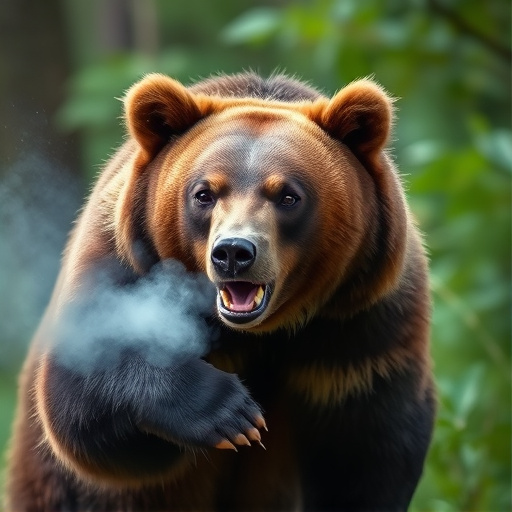Understanding bear spray dynamics is crucial for safety in Alaska's wilderness. The effective shooting distance (ESD) of 20-35 feet (6-10 meters) depends on atmospheric conditions, terrain, and user proficiency. Practice, proper application techniques, and high-quality spray maximize ESD. Regular training, maintenance, and compliance with guidelines ensure safe use during bear encounters.
Alaska’s rugged terrain demands knowledge of bear spray dynamics for visitors and residents alike. Understanding the fog pattern of bear spray is crucial for effective self-defense. This article explores the science behind the spray’s range, factoring in wind, terrain, and canisters’ design. We’ll guide you through maximizing your bear spray reach, offering tips to ensure safety during encounters. Learn about real-world applications and consider essential safety measures to make informed decisions when facing potential bear threats.
- Understanding Bear Spray Fog Pattern Dynamics
- Factors Influencing Effective Shooting Distance
- Maximizing Bear Spray Range: Tips and Tricks
- Real-World Applications and Safety Considerations
Understanding Bear Spray Fog Pattern Dynamics
Understanding the dynamics of bear spray fog pattern is crucial for effective defensive preparation in Alaska’s rugged wilderness. The shooting distance and range of bear spray are significantly influenced by several factors, including atmospheric conditions, terrain, and the user’s proficiency. In ideal conditions, bear spray can be effective up to 30 feet (9 meters), creating a dense fog that disrupts a bear’s senses. However, this range can vary greatly; wind, for instance, can extend or reduce the effective shooting distance significantly.
Topography also plays a role, as hills or trees can disrupt the spray pattern, while open spaces allow for better dispersion. It’s important to remember that proper application techniques are paramount. Holding the canister at the appropriate angle and distance ensures maximum fog density, enhancing the spray’s effectiveness in deterring aggressive bears. Understanding these dynamics empowers individuals to make informed decisions when navigating bear country, ensuring their safety and well-being while outdoor exploring in Alaska.
Factors Influencing Effective Shooting Distance
The effectiveness of bear spray depends heavily on the shooting distance, with optimal range varying based on several key factors. One primary consideration is the user’s proximity to the bear. The closer the bear, the shorter the effective shooting distance, as the spray needs to cover a smaller area quickly to be impactful. Terrain also plays a crucial role; in open areas, spray can travel further due to reduced air resistance and fewer obstacles, while dense foliage or rough terrain can significantly reduce the effective range.
Another factor influencing bear spray’s effectiveness is weather conditions. Wind, for instance, can affect the direction and dispersion of the spray, potentially reducing its impact. Moisture in the air can also cause the spray to dissipate faster, while dry conditions may allow it to travel further. User proficiency and the type of bear spray used are equally important; experienced users with high-quality spray may achieve better results at greater distances compared to novices or those using lower-grade products.
Maximizing Bear Spray Range: Tips and Tricks
Maximizing the range of your bear spray is crucial for effective self-defense in Alaska’s rugged wilderness. To ensure optimal coverage, it’s essential to understand the factors influencing bear spray projection. One key tip is to practice your shooting technique regularly; this fine-tunes your aim and allows you to control the spray’s direction precisely. Aim slightly below the bear’s chest level; this technique helps project the spray upward, covering a broader area.
The fog pattern created by bear spray plays a vital role in its effectiveness. Look for bear spray canisters designed with advanced fog technology, which breaks down the spray into smaller droplets, extending the range and ensuring better penetration. Additionally, consider practicing in various weather conditions; calm, dry air allows for longer-range projections, while windier environments require adjustments to your technique to maintain accuracy at closer ranges.
Real-World Applications and Safety Considerations
In real-world applications, bear spray has proven its effectiveness in various scenarios, particularly within the specified effective shooting distance range of 20-35 feet (6-10 meters). This non-lethal deterrent is widely used by outdoor enthusiasts, hikers, campers, and park rangers to protect themselves from unexpected bear encounters. When deployed correctly, the fog pattern created by bear spray can disrupt a bear’s sense of smell and vision, temporarily incapacitating it enough for the user to escape or gain time to reach safety.
Safety considerations are paramount when using bear spray. It’s crucial to understand the spray’s range and not rely solely on its effectiveness beyond the recommended distance. Users should also be trained in proper usage, including techniques for aiming and activating the spray. Additionally, regular maintenance of the equipment ensures it is always ready for use. Awareness of local regulations and guidelines regarding bear spray possession and use is essential to ensure compliance with conservation efforts and public safety standards.
Understanding the fog pattern dynamics of bear spray is paramount for ensuring its effectiveness at various distances. By grasping the factors influencing shooting range, individuals can maximize the potential of this crucial self-defense tool in Alaska’s diverse terrain. With proper technique and knowledge, users can enhance their safety when encountering bears, making every shot count within the optimal bear spray effective shooting distance and range.
